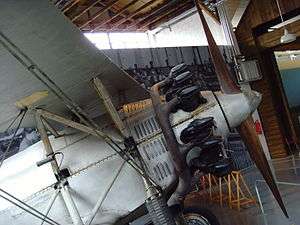Piaggio Stella P.VII
The Piaggio Stella P.VII was the first P series aircraft engine produced by Rinaldo Piaggio S.p.A.. Based on its experience license-producing the Gnome-Rhône 7K, Piaggio sold the engine to be used on a wide range of Italian aircraft before and during World War II, including the record-breaking Caproni Ca.133.
| Piaggio Stella P.VII | |
|---|---|
 | |
| P.VII mounted on the Caproni Ca.113 in Volandia | |
| Type | Air cooled radial |
| National origin | Italy |
| Manufacturer | Piaggio |
| Designed by | Renzo Spolti |
| First run | 1933 |
| Major applications | Caproni Ca.113; Caproni Ca.133; Caproni Ca.310 |
Development
Having built engines under licence from Gnome et Rhône, Piaggio designed a seven-cylinder radial using the same principles.[1] The engine, named P.VII for its seven cylinders, was one in a series of radial engines produced by Piaggio initially named Stella, meaning star.[2] The engine was first run in 1933 and was produced in many models.[3] One notable version was the P.VII Z which was fitted with a floatless Piaggio AS80 carburettor for aerobatic flight. It powered the Caproni Ca.133 flown by Renato Donati that, in 1933, broke the record for the longest duration in inverted flight.[2]
Variants
- P.VII C.15
- Supercharged, rated at 331 kW (444 hp) at 1,500 m (4,900 ft); first flew 1933
- P.VII C.16
- Supercharged, rated at 338 kW (453 hp) at 1,600 m (5,200 ft); first flew 1934
- P.VII C.16/35
- P.VII C.35
- Supercharged, rated at 338 kW (453 hp) at 3,500 m (11,500 ft); first flew 1935
- P.VII C.40
- Supercharged, rated at 287 kW (385 hp) at 4,000 m (13,000 ft); first flew 1935
- P.VII C.45 / 2v
- Two speed supercharged, rated at 287 kW (385 hp) at 4,500 m (14,800 ft); first flew 1935
- P.VII R.C.10
- Supercharged and geared, rated at 1,000 m (3,300 ft).
- P.VII R.C.35
- Supercharged and geared, rated at 368 kW (493 hp) at 3,500 m (11,500 ft); first flew 1938
- P.VII R.C.45
- Supercharged and geared, rated at 287 kW (385 hp) at 4,500 m (14,800 ft) first flew 1935
- P.VII Z
- Normally aspirated, designed for acrobatic aircraft, rated at 272 kW (365 hp), first flew 1933
Applications
Specifications (C.35)
Data from S.A. Piaggio e.C. (1939). Instruzione per l’uso del motore P VII C 35 – D P VII C 35 – S. Rome: Ministero dell’Aeronautica. Retrieved 29 August 2018.
General characteristics
- Type: 7-cylinder, single row, air cooled radial engine
- Bore: 146 mm (5.7 in)
- Stroke: 165 mm (6.5 in)
- Displacement: 19.337 l (1,180 in3)
- Length: 1,050 mm (41 in)
- Diameter: 1,235 mm (48.6 in)
- Dry weight: 295 kg (650 lb)
Components
- Valvetrain: 2 x overhead valves per cylinder operated by rockers and pushrods
- Supercharger: Centrifugal compressor
- Fuel type: 87 Octane petrol
- Cooling system: Air-cooled
Performance
- Power output:
- Take-off: 368 kW (493 hp) at 2100 rpm
- Cruise: 338 kW (453 hp) at 2100 rpm at 3,500 m (11,483 ft)
- Compression ratio: 5.5:1
- Specific fuel consumption: 292 g/(kW•h) (0.48 lb/(hp•h)) at 1900 rpm
- Oil consumption: 9.5 g/(kW•h) (0.015 lb/(hp•h)) at 1900 rpm
See also
Comparable engines
Related lists
References
| Wikimedia Commons has media related to Piaggio P.VII. |
- Gunston, Bill (1986). World Encyclopedia of Aero Engines. London: Guild Publishing. p. 125.
- "PVII C35 engine". Museo Piaggio. Archived from the original on 26 August 2017. Retrieved 29 August 2018.
- Angle, Glenn Dale (1939). Aerosphere. New York: Aircraft Publications. p. 584.